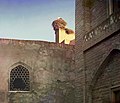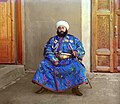Bukhara
Bukhara (بُخارا in Persian, Buhe/Puhe Tang Chinese,Buxoro or Бухоро in Uzbek (the Cyrillic alphabet was officially phased out for Uzbek after independence); Бухара in Russian; also Boxara in Tatar) is one of the major cities of Uzbekistan, and capital of the Bukhara region (Bukhoro Wiloyati). The majority of the city's population are Persian-speaking Tajiks. Bukhara and Samarkand are the two major centers of the Tajiki-Persian culture and history. During Soviet times these two Tajiki centers were annexed to the Uzbekistan SSR, much to the disgust of the Tajiks of Central Asia. Ever since, a harsh program of assimilation and cultural confinement has been carried out on the Tajiks of Uzbekistan by the Uzbek authority.
Bukhara is also home to a large number of Jews, whose ancestors settled in the city during Roman times. The term 'Bukharan Jew' is frequently used to describe all Jews who come from Central Asia.

History
Bukhara has been one of the main centers of Iranian civilization during its history. Its architecture and archaeological sites form one of the pillars of the Persian history and art. The region of Bukhara was for a long period a part of the Persian Empire. The origin of its inhabitants goes back to the period of Aryan immigration into the region. Iranians Soghdians inhabited the area and some centuries later the Persian language became dominant among them. The Last emir of Bukhara was Muhammad Alim Khan (1880-1944).
The historic center of Bukhara has been listed by UNESCO as one of the World Heritage Sites. It contains numerous mosques and madrassas.
A statue of the populist philosopher and wise man Nasreddin can be found in a central square. It shows him riding his donkey backwards and grasping its tail, as he is traditionally depicted.
References
- Moorcroft, William and Trebeck, George. 1841. Travels in the Himalayan Provinces of Hindustan and the Panjab; in Ladakh and Kashmir, in Peshawar, Kabul, Kunduz, and Bokhara... from 1819 to 1825, Vol. II. Reprint: New Delhi, Sagar Publications, 1971.
-
Study of a Stork's Nest at the top of a palace wall, before 1915
-
Citadel of Bukhara
-
City skyline of Bukhara, dominated by the Kalon minaret
-
Ark fortress walls, home to the Khans of Bukhara
-
A view from the inside of the Poi Kalon mosque, showing the Kalon minaret
-
Chor Minor, the gatehouse to a now-disappeared madressah
-
Entrance to the emir's palace
-
Alim Khan (1880-1944), last emir of Bukhara







